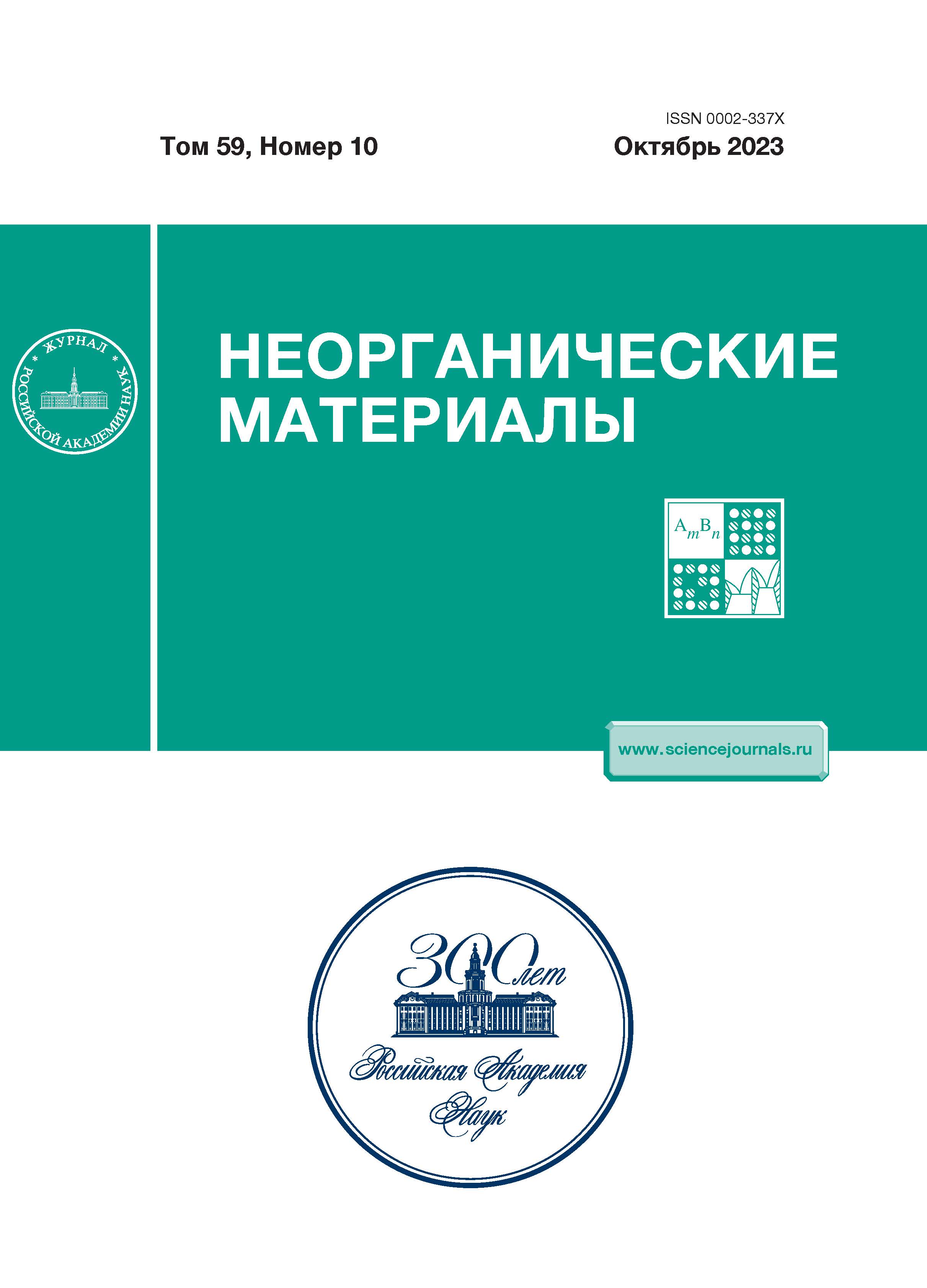Synthesis and Thermodynamic Functions of Ruthenium Ditelluride
- Authors: Polotnyanko N.A.1, Tyurin A.V.2, Chareev D.A.1,3,4,5, Khoroshilov А.V.2, Popov E.A.6
-
Affiliations:
- Dubna State University
- Kurnakov Institute of General and Inorganic Chemistry, Russian Academy of Sciences
- Korzhinskii Institute of Experimental Mineralogy, Russian Academy of Sciences
- Institute of Physics and Technology, Yeltsin Federal University
- Kazan (Volga Region) Federal University
- Dubna State University,
- Issue: Vol 59, No 10 (2023)
- Pages: 1095-1104
- Section: Articles
- URL: https://medjrf.com/0002-337X/article/view/668081
- DOI: https://doi.org/10.31857/S0002337X2310010X
- EDN: https://elibrary.ru/APQKFI
- ID: 668081
Cite item
Abstract
In this paper, we report the synthesis of crystalline ruthenium ditelluride (RuTe2) and its thermodynamic properties in the range from 10 to 965 K, evaluated from its isobaric heat capacity Cp determined using calorimetry. At low temperatures, between 6.86 and 335.11 K, the heat capacity of the synthesized material—pure, free of impurities and foreign phases—was determined by adiabatic calorimetry. In the range 315.3–965.3 K, Cp was determined by differential scanning calorimetry. The data obtained above 298 K have been used to determine empirical coefficients of the Maier–Kelley and Khodakovsky equations. In the range 10–965 K, we have evaluated the standard thermodynamic functions: heat capacity, entropy, enthalpy increment, and reduced Gibbs energy. At 298.15 K, we have obtained
= 72.43 ± 0.14 J/(K mol), S° = 94.94 ± 0.19 J/(K mol), Н°(298.15 K) − Н°(0) = 14.60 ± 0.03 kJ/mol, and Ф° = 45.97 ± 0.09 J/(K mol). Using the absolute entropy determined by us and data in the literature and handbooks, we have estimated the standard Gibbs energy of formation of RuTe2: ΔfG°(RuTe2, cr, 298.15) = −130.5 ± 2.9 kJ/mol.
About the authors
N. A. Polotnyanko
Dubna State University
Email: d.chareev@gmail.com
141982, Dubna, Moscow oblast, Russia
A. V. Tyurin
Kurnakov Institute of General and Inorganic Chemistry, Russian Academy of Sciences
Email: fomina@igic.ras.ru
Moscow, Russia
D. A. Chareev
Dubna State University; Korzhinskii Institute of Experimental Mineralogy, Russian Academy of Sciences; Institute of Physics and Technology, Yeltsin Federal University; Kazan (Volga Region) Federal University
Email: d.chareev@gmail.com
141982, Dubna, Moscow oblast, Russia; 142432, Chernogolovka, Noginskii raion, Moscow oblast, Russia
А. V. Khoroshilov
Kurnakov Institute of General and Inorganic Chemistry, Russian Academy of Sciences
Email: guskov@igic.ras.ru
Russian Federation, 119991, Moscow
E. A. Popov
Dubna State University,
Author for correspondence.
Email: polot.nat@gmail.com
141982, Dubna, Moscow oblast, Russia
References
- Тюрин А.В., Полотнянко Н.А., Тестов Д.С., Чареев Д.А., Хорошилов А.В. Термодинамические функции дисульфида платины PtS2 в широком интервале температур // Неорган. материалы. 2020. Т. 56. № 2. С. 125‒134. https://doi.org/10.31857/S0002337X20020177
- Полотнянко Н.А., Тюрин А.В., Чареев Д.А., Хорошилов А.В. Теплоемкость и термодинамические функции PdS // Неорган. материалы. 2020. Т. 56. № 7. С. 719‒726. https://doi.org/10.31857/S0002337X20070131
- https://catalogmineralov.ru/mineral/laurite.html
- Svendsen S.R. Decomposition Pressures and Thermodynamic Properties of RuTe2 // J. Chem. Thermodyn. 1977. V. 9. № 8. P. 789‒800. https://doi.org/10.1016/0021-9614(77)90023-4
- Wang J., Han L., Huang B., Shao Q., Xin H.L., Huang X. Amorphization Activated Ruthenium-Tellurium Nanorods for Efficient Water Splitting // Nat. Commun. 2019. V. 10. P. 5692. https://doi.org/10.1038/s41467-019-13519-1
- Yang T.R., Huang Y.S., Chyan Y.K., Chang J.D. Optical Absorption Studies of Pyrite-Type RuS2, RuSe2 and RuTe2 Single Crystals // Czech. J. Phys. 1996. V. 46. P. 2541–2542. https://doi.org/10.1007/BF02570257
- Zhussupbekov K., Ansari L., McManus J.B., Zhussupbekova A., Shvets I.V., Duesberg G.S., Hurley P.K., Gity F., Ó Coileáin C., McEvoy N. Imaging and Identification of Point Defects in PtTe2 // npj 2D Mater. Appl. 2021. V. 5. P. 14. https://doi.org/10.1038/s41699-020-00196-8
- Foise J.W., Ezzaouia H., Gorochov O. Crystal Growth and Characterization of RuTe2 // Mater. Res. Bull. 1986. V. 21. № 1. P. 7–11.
- Chareev D.A., Evstigneeva P., Phuyal D., Man G.J., Rensmo H., Vasiliev A.N., Abdel-Hafiez M. Growth of Transition-Metal Dichalcogenides by Solvent Evaporation Technique // Cryst. Growth Des. 2020. V. 20. № 10. P. 6930‒6938. https://doi.org/10.1021/acs.cgd.0c00980
- https://www.hypergrid.it/eshopen/
- Program PCPDFWIN Version 2.02 Copyright © 1999.
- http://database.iem.ac.ru/mincryst/rus/index.php
- Program TOtal Pattern Analysis Solutions. © 2008 Bruker AXS
- Varushchenko R.M., Druzhinina A.I., Sorkin E.L. Low Temperature Heat Capacity of 1-Bromoperfluorooctane // J. Chem. Thermodyn. 1997. V. 29. № 6. P. 623−637. https://doi.org/10.1006/jcht.1996.0173
- http://www.physics.nist.gov/PhysRefData/Compositions
- Иориш В.С., Толмач П.И. Методика и программа обработки экспериментальных данных по низкотемпературной теплоемкости с использованием аппроксимирующего сплайна // Журн. физ. химии. 1986. Т. 60. № 10. С. 2583−2587.
- Гурвич Л.В. ИВТАНТЕРМО – автоматизированная система данных о термодинамических свойствах веществ // Вестн. АН СССР. 1983. № 3. С. 54–65.
- Maier C.G., Kelley K.K. An Equation for the Representation of High-Temperature Heat Content Data // J. Am. Chem. Soc. 1932. V. 54. P. 3243−3246. https://doi.org/10.1021/ja01347a029
- Ходаковский И.Л. О новых полуэмпирических уравнениях температурной зависимости теплоемкости и объемного коэффициента термического расширения минералов // Вестн. ОНЗ РАН. 2012. Т. 4. C. 9001. https://doi.org/10.2205/2012NZ_ASEMPG
- Медведев В.А., Бергман Г.А., Васильев В.П. и др. Термические константы веществ (ред. Глушко В.П.) Вып. VI. М.: АН СССР. ВИНИТИ. 1972.
Supplementary files
















